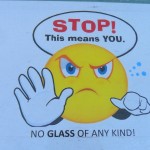25 February 2013/14 Raby’ ath-Thani 1434/07 Esfand 1391
This past weekend, while dropping off recycling at the Chubbuck, Idaho, dumpsters next to City Hall, I noticed they’ve put new signs up: No glass and no styrofoam!
Click pics to make bigger
- People throwing glass & styrofoam into recycling dumpster has city officials pi….upset!
- Chubbuck, Idaho, says no to glass recycling.
Chubbuck officials are so upset about non-recylables being thrown into recycling containers that they will now fine anyone who puts non-recyclables into their residential recycling dumpsters. City officials say the recycling company is taking those mis-filled dumpsters to the landfill, rather than spend the money on manpower to sort the contents.
I wrote about this more than two years ago, concerning the recycling dumpsters for the city of Pocatello.
Back then there were some glass and styrofoam recyclers in other parts of Idaho. I just checked the Department of Environmental quality’s web site, and I counted about 18 glass recyclers and one styrofoam recycler (however, just like two years ago, when I check that recycler’s web site there’s no mention of styrofoam recycling). None of those recyclers are in our southeastern Idaho area. The cost to transport such items out of the area will cancel any cost savings or revenue enhancements that cities are trying to achieve with their recycling programs.
Here’s why recycling glass is a waste of money, and does not help the environment: One of the fallacies in the argument for glass recycling is that recycling glass bottles uses 40% less energy than making it from new materials. This argument does not take into account the increasing costs of transporting the old glass to the recycling centers, and then to the consumers, when you do it becomes more expensive.
According to the Oklahoma State University Cooperative Extension Service, ever increasing costs of transportation actually makes glass recycling more costly than making glass from raw materials. The ingredients of glass are soda ash, limestone and sand (silica). None of these materials are in short supply, making them relatively cheap.
Next, the Michigan Technology University Institute of Materials Processing points out that the cost of employing people to handle the recycled glass also makes recycling more expensive than making glass from raw materials. Efforts are being made to convince buyers of glass to use mixed colored glass bottles, which would cut way back on the number of people needed to sort glass bottles at recycling factories.
Also, employees involved in glass recycling cost more to their employers because of insurance liability reasons, according to the Joint Service Pollution Prevention and Sustainability Technical Library.
In the parts of Idaho that do recycle glass, it is mainly for use in road construction, not for making new glass bottles. Studies show this type of use for recycled glass is the least costliest. As is simply pulverizing the glass into powders that can be used in ceramics, plastics or brick making.
When it comes to the environment, we can go back to transportation issues. Trucks create pollution by using up petroleum based fuels and oils. Another claim is that glass is hurting landfills, which is impossible because glass is the most inert product made by humans (only if you cut yourself with it, but who’s gonna go digging around in a landfill).
Another issue, glass from windows and mirrors can not be recycled. They can only be crushed into powder for possible use in construction. Also, according to the Parliamentary Office of Science and Technology, less than 40% of a glass container can be recycled. And those Pyrex or Anchor Hawking brand glass kitchen utensils are not recyclable (they are treated the same way windows and mirrors are).
Not only can you not recycle windows and mirrors, but you can not use recycled glass to make new windows: “As it pertains to green programs, architectural glass currently has very little opportunity to take advantage of the use of recycled glass.”-Tracy Rogers, Technical Director for Edgetech IG
The reasons that new windows and mirrors are made from new materials are: The raw materials are cheaper (see above). Glass making is a very specific process, what type of glass you want depends greatly on how you blend the ingredients (called Cullet), window glass is not the same as glass for bottles.
Even if you replace your old windows with new ones, the old glass can not be recycled into new windows, it typically goes into the garbage dump. The only other thing they can do is what the industry calls “down-cycling”, turning it into a lesser quality product for use in fiberglass or road construction (see above), but that is expensive because they must separate frames, spacers and even the laminate before down-cycling.
And, finally, glass that is already broken is not accepted, because the recycler can’t tell exactly what kind of glass they’re dealing with.
Now what about styrofoam? Recycling styrofoam (foamed or expanded polystyrene, the same plastic used to make model kits) is expensive because it does not break down as easily as other plastics. Also, since the invention of starch based ‘foams’ styrofaom is actually no longer needed. Starch based foams can be broken down incredibly cheaply and easily simply by soaking them in water.
I hate those styrofoam packing peanuts, but what can you do with them? Some shipping companies will gladly take those packing peanuts you get with that latest order from Amazon or ebay. In fact that seems to be the most effective way of recycling styrofoam packing peanuts.
As far as styrofoam containers, or boards or sheets, we model builders have been recycling them into diorama bases for years. It’s also been used for architectural and railroad model building. But we can’t use it all, and they don’t react well with oil based paints (you have to use a water based primer first).
Bottom line, recycling glass and styrofoam does not pay off, and stop throwing them into southeast Idaho recycling dumpsters!

